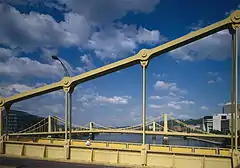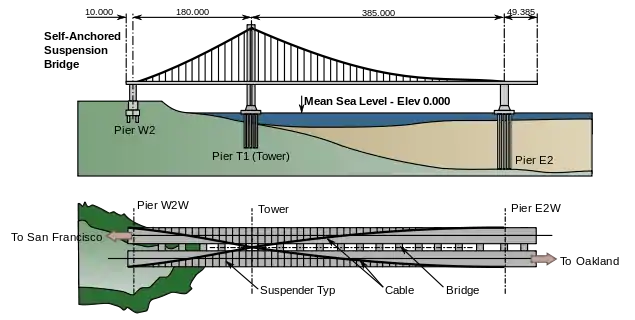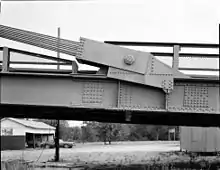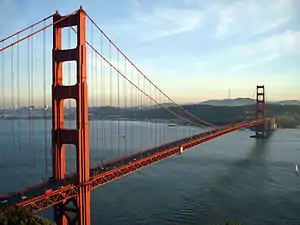Self-anchored suspension bridge
A self-anchored suspension bridge is a suspension bridge in which the main cables attach to the ends of the deck, rather than to the ground via large anchorages. The design is well-suited for construction atop elevated piers, or in areas of unstable soils where anchorages would be difficult to construct.
- Difference between types of bridges
 Suspension bridge with the main cables attached to the ground (black squares)
Suspension bridge with the main cables attached to the ground (black squares) Self-anchored suspension bridge; the main cables are attached to the end of the road deck
Self-anchored suspension bridge; the main cables are attached to the end of the road deck
 Three self-anchored suspension bridges in Pittsburgh | |
| Ancestor | Suspension bridge |
|---|---|
| Related | None |
| Descendant | None |
| Carries | Pedestrians, automobiles, trucks, light rail |
| Span range | Medium |
| Material | Steel rope, steel eyebar, concrete spar, post-tensioned concrete deck |
| Movable | No |
| Design effort | high |
| Falsework required | Sometimes |
The load path of the self-anchored suspension (SAS) bridge converts vertical loads into tension forces in the main cables which are countered by compressive forces in the towers and deck. The system balances forces internally without external anchorage requirements making it suitable for sites where large horizontal forces are difficult to anchor. This is similar to the method used in a tied-arch bridge where arch member compression is balanced by tension in the deck.
History
The self-anchored suspension bridge form originated in the mid-19th century, with a published description by Austrian engineer Josef Langer in 1859 and U.S. Patent No. 71,955 by American engineer Charles Bender in 1867. The form was applied to a handful of Rhine River crossings in Germany during the first half of the twentieth century.[1]
Examples
- The SAS portion of the eastern span replacement of the San Francisco–Oakland Bay Bridge became self-supporting in November 2012, with a 385 m span. This is a unique, half-span as the bridge has only a single tower. It is currently the largest SAS bridge in the world.[2]
- the Konohana Bridge (1990) in Japan and the Yeoungjong Grand Bridge (2000) in South Korea, both have a central span of 300 m.
- The Three Sisters Bridges of Pittsburgh are the earliest examples (1924–28) of this bridge type in the US.
- The Chelsea Bridge (1937) in London, England.
- The Gagarin Street Bridge in Arkhangelsk, Russia.
 Construction falsework on left; force schematic on right
Construction falsework on left; force schematic on right Asymmetrical single tower half span is a self-supporting SAS bridge -- part of eastern span of San Francisco-Oakland bay bridge
Asymmetrical single tower half span is a self-supporting SAS bridge -- part of eastern span of San Francisco-Oakland bay bridge
Construction method
The nature of the self-anchored suspension bridge necessitates the temporary construction of falsework, in the form of compression struts or an underdeck, before work begins on the permanent structure. This requirement is inherent in the structure's definition.
In the absence of suspension via cableage, the deck of a suspension bridge is incapable of self-support. On a suspension bridge of the more usual earth-anchored type, both of the primary (i.e., horizontal) cable's anchorages exist prior to construction in the form of solid terrain. In the self-anchored suspension bridge, however, the cable must be anchored to the bridge deck, which has yet to be built and will not bear its own weight; ergo, falsework must be employed until the final method of suspension is possible.
Cable anchors

As in a traditional suspension bridge, the primary cable type may be multiple parallel independent cables as in the image at right of the Hutsonville Bridge (no longer extant), or eyebars, or a more conventional composite cable.
References
- John A. Ochsendorf and David P. Billington, "Self-Anchored Suspension Bridges," ASCE Journal of Bridge Engineering, vol. 4, No. 3 (August 1999): 151-156.
- Cabanatuan, Michael (21 November 2012). "Bay Bridge span's 'Big Lift' complete". SF Gate. Retrieved 13 January 2013.
External links
- Yeonglong Grand Bridge A two tower, three span self-anchored bridge
